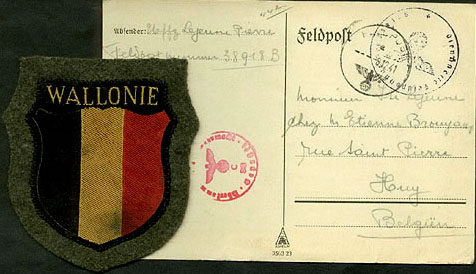|
Corps Franc Wallonie
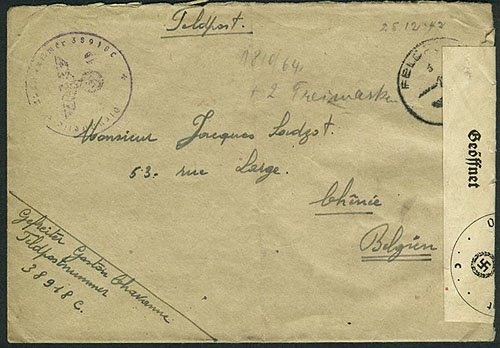
Rere feldpost cover mailed by a Walloon volunteer on Christmas day December 25, 1942
In March 1942, the battalion was withdrawn from
the Eastern Front after losing half of its personnel including
20 of the 22 Officers. After refitting in Germany, it was acting
as a reserve unit of the German 68th Infantry Division but was
transferred to the "97. Jager Division." The Legion was placed
under the command of Belgian officer Lucien Lippert. In July,
the Legion became involved in heavy fighting on the River Don
opposite Stalingrad. Fortunately for the Walloons, they were withdrawn
and sent to Kharkov. There the Legion traveled 800 Kms in one
month and arrived in the Caucasus region, where it fought at Maikop
so distinctively that the Germans were impressed with the fighting
capabilities of the Walloons. | |
|
5. Freiwilligen Sturmbrigade der Wallonien 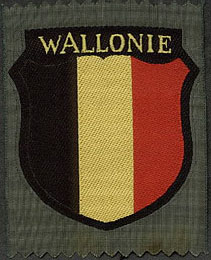
Wallonie Legion Shield
By June 1943, 1600 veterans of the Legion were incorporated into the Waffen-SS.
The formation along with another 400 recruits was sent to a training camp near
Meseritz. Then it was sent to the training camp at Wildflecken, where it was
better equipped. On 3 July 1943, it was designated the "Freiwilligen Sturmbrigade
der SS Wallonien" and was placed under the command of Lt-Col Lucien Lippert with
the rank of SS-Sturmbannführer | |
|
28. Freiwilligen Panzer-Grenadier Division der SS Wallonien 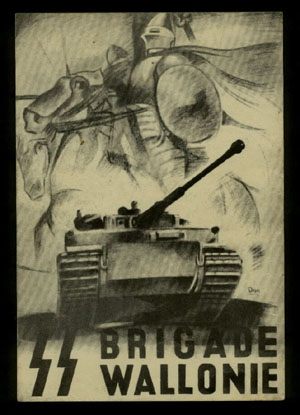
The Walloons were organized and refitted in Breslau then in South Hannover and
Braunschweig, Germany. The volunteers consisted of former Legionnaires and refugees
from Belgian and France, who were leaving their homeland from the wake of the allied
invasion. Pomerania In Pomerania, the Walloon Division was prepared for the
participation of Operation "Sonnenwende" (Solstice). This major offensive operation
was entrusted to SS-Obergruppenführer Feliz Steiner's 11th SS Panzer Army. In Operation
Sonnenwende there were three main attacking groups: | |
|
Walloon Postal History Postal History: Free postal privileges for mail weighing up to 250gms, were given to Walloons while serving in the German Arm-forces. A fee of 3 Francs was charged for mail weighing 250 to 1000gms. The separatist Walloons issued a set of four propaganda labels for the Wallonien Legion. | |
|
Feldpost numbers assigned to the Walloon Legion In August 1941, the Walloon Corps was used to form the 373rd Infantry Battalion, which was assigned the following Feldpost unit numbers: Staff Hqtr Btl-------------- 38918A 1st. Rifle Co. -------------- 38918B 2nd. Rifle Co.-------------- 38918C 3rd. Rifle Co.--------------- 38918D 4th. Heavy Inf. Co.------ 38918E
Walloon Legion Feldpost The Walloon Legion Feldpost cover shown above was mailed from FPN 38918B (1st Rifle Co.). | |
|
In July 1943, the Walloon Corps was incorporated into the Waffen-SS to form the new Assault Brigade Walloon, the following Feldpost numbers were assigned as follows: Brigade Staff------------------------------------- 38918 War Reporters Platoon------------------------- 31954 1st. Btl. (1-4 Co.)---------------------------------------28193A-D 2nd. Btl. (5-8 Co.)--------------------------------------16821A-D 1st Assault Gun Battery-------------------------37572 2nd Assault Gun Battery------------------------41163 8.8cm Anti-aircraft Battery---------------------25151 2.2cm Anti-aircraft Battery---------------------41461 Anti-tank Co.--------------------------------------43857 Intelligence Co.-----------------------------------36637 1st Field Reserve Co.---------------------------42059 2nd Field Reserve Co.---------------------------18909 Heavy Transportation Column----------------38714 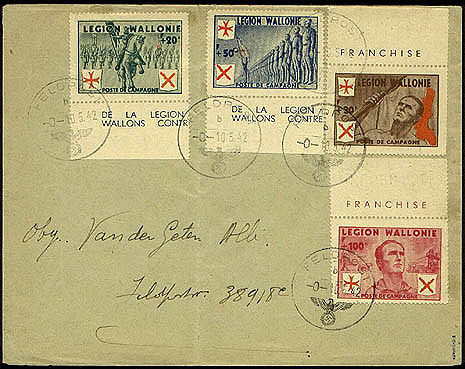
Walloon Legion Feldpost Interesting feldpost cover mailed to Mr. Van der Geten, a Flemish who volunteer in the Walloon Legion. The feldpost was mailed in May 1942 to FPN 38918C, 2nd Rifle Co. In September 1944, the Brigade was reformed as 28th SS Volunteer Panzer Grenadier Division Walloon. The Division was assigned the Tatical No. SS-28 and Kenn No. 755. The following Feldpost numbers were assigned as follows: Divisional Staff---------------------------------- 38918 SS Volunteer Pz-Grenadier Regiment 69 Regimental Staff-------------------------------- 28193 1st. Btl. (1-4 Co.)------------------------------------- 00385A-D 2nd. Btl. (5-8 Co.)------------------------------------ 01379A-D SS Volunteer Pz-Grenadier Regiment 70: Regimental Staff------------------------------- 16821 1st. Btl. (1-4 Co.)------------------------------------ 01379A-D 2nd. Btl. (5-8 Co.)------------------------------------ 06974A-D 
As indicated by June 1943, 1600 veterans of the Legion were incorporated into the Waffen-SS. The formation along with another 400 recruits was sent to a training camp near Meseritz. Then it was sent to the training camp at Wildflecken, where it was better equipped. On 3 July 1943, it was designated the "Freiwilligen Sturmbrigade der SS Wallonien" and was placed under the command of Lt-Col Lucien Lippert with the SS rank of Obersturmbannführer. SS Volunteer Artillery Regiment 28: 1st. Btl. ---------------------------------------- Not completed 2nd. Btl. ---------------------------------------------- 02544A-D 3rd. Btl. ----------------------------------------------- 65856A-D Motor Co. 28: Mobile Repair Detachment------------------- 38714 Medical Co. & Ambulance Co.---------------- 03277 Signals Section 28--------------------------------- 36637 Engineer Btl.---------------------------------------- 25151 Logistic Co.----------------------------------------- 04712 Field Ordnance Co.------------------------------- 41461 Armored Fighter Btl.------------------------------ 43857 Veterinary Co.---------------------------------------18909 Field Postoffice 28.--------------------------------- 03487 |
|
[ Front Page ] [ Top] [Previous Page [ Next Page]
 Political fascist parties already existed in Belgium by the time
Germany began occupying the country. These political parties were
already prepared to collaborate with the Germans. Leon Degrelle
was a pro-Nazi collaborator who founded the "Rexist Party."
Political fascist parties already existed in Belgium by the time
Germany began occupying the country. These political parties were
already prepared to collaborate with the Germans. Leon Degrelle
was a pro-Nazi collaborator who founded the "Rexist Party." Leon Degrelle was flown to Hitler's headquarters in East Prussia, where he personally awarded Degrelle the Knights Cross.
Leon Degrelle was flown to Hitler's headquarters in East Prussia, where he personally awarded Degrelle the Knights Cross. 